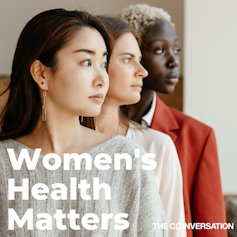During the pandemic, there had been concerns from healthcare professionals that the restrictions placed on daily life would lead to a disruption in breastfeeding. But our new research shows that the number of women who continued to exclusively breastfeed for six months increased.
And in fact, women were 40% more likely to exclusively breastfeed for six months during COVID than they were before the pandemic or now, post-pandemic.
The World Health Organization (WHO) recommends exclusively breastfeeding for the first six months of a baby’s life. But the UK has had the lowest breastfeeding rates globally. Only 0.5% of women breastfed their baby until they were one year old in the UK. This is compared to 27% of mothers in the United States, 35% in Norway and 44% in Mexico, who were still breastfeeding after one year.
When COVID hit, there had been concern that the virus could be passed from mothers to babies.

This article is part of Women’s Health Matters, a series about the health and wellbeing of women and girls around the world. From menopause to miscarriage, pleasure to pain the articles in this series will delve into the full spectrum of women’s health issues to provide valuable information, insights and resources for women of all ages.
You may be interested in:
Spain is the egg donation capital of Europe – here’s what it’s like to be a donor
‘Dirty red’: how periods have been stigmatised through history to the modern day
The orgasm gap and why women climax less than men
Numerous studies reported a lack of support for expectant and new mothers who were breastfeeding during the pandemic. For instance, one in three women intending to breastfeed reported lacking assistance with proper positioning, while one in four women stated insufficient hospital-based breastfeeding support. This was probably due to strained healthcare systems and the push to minimise infection risks.
Support for new mothers lessened, which hindered breastfeeding. And pregnant women reported very high levels of anxiety and stress, including uncertainty about the vaccine.
We conducted surveys with women who gave birth in Wales between 2018 and 2021 and we examined anonymised NHS breastfeeding health data collected by midwives and health visitors.
Surprisingly, breastfeeding rates up to six months peaked in 2020, a time of strict pandemic restrictions. This conflicts with the anticipated decrease in breastfeeding rates due to reduced access to professional and social support.
Our research also shows that approximately six in ten women in Wales breastfeed for their baby’s first feed, but only three in ten are still breastfeeding at ten weeks. And more than 80% of women are not breastfeeding at all by six months.
This finding has surprised us and others working in healthcare since the pandemic had such a profound impact on daily life worldwide.

Our study also shows that when pregnant women report that they do not intend to breastfeed, then they are very unlikely to start breastfeeding. About 30% of women do not intend to breastfeed at all.
However, when women say in pregnancy that they intend to breastfeed, then approximately 90% of these women do start doing so. They are also 27 times more likely to breastfeed for six months compared to women who did not intend to breastfeed.
The time factor
But what is it that helps women who do want to breastfeed, do so for longer? We know that even without the support systems and training by midwives, more women who wanted to breastfeed were able to for longer during the pandemic.
These findings could mean that one thing women really need to help them to breastfeed is more time at home with their baby, more time with their partner at home with them, more privacy and more flexible working.
If we want to increase breastfeeding levels, it is possible that what the pandemic has taught us is the need to address working environments as well as medical services.
Breastfeeding benefits
Breastfeeding has many benefits, including fewer infections, increased intelligence and the prevention obesity and diabetes. Breastfeeding also has advantages for mothers as it lessens the risk of cancers, postpartum bleeding and helps with weight loss after birth.
It is better for the environment and can be cheaper for some families.
But a study by Yale School of Medicine earlier this year found that a year of breastfeeding can also cost families up to US$11,000 (£8,700) with increased food intake, vitamins, supplements and supplies. It stressed that the barrier of cost may impact a mother’s decision to breastfeed.
But the cost of breastfeeding involves more than just money. Another more hidden cost is the time dedicated to breastfeeding or pumping breast milk. This highlights how women need more time at home and how we should be reassessing working environments, especially for lower income families.
The short term gains of getting parents back to work should not outweigh the long term benefits to our society from having healthier families. If we want to improve breastfeeding rates in the UK, then we need to look at the working lives of women and their partners across the nation.

